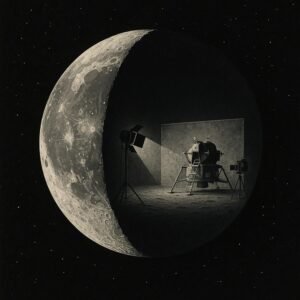
The Hollow Moon and the Forgotten Lie
The Question That Won’t Die
In 1969, the world watched as Apollo 11 touched down on the Moon. Or so we were told. More than half a century later, the event still echoes through conspiracy theories, whispered secrets, and uncomfortable silences. Why did we never return after 1972? Why did the astronauts seem subdued, even traumatized? Why does the footage seem off, almost theatrical? And what exactly did they see up there?
This isn’t just about a hoax. It’s about geopolitics, cinema, occult symbolism, and the possibility that the Moon is not what we think it is.
1. The Real Mission: Psychological Supremacy
The Moon landing was never really about science. It was about optics. The Cold War was raging, and after the USSR’s firsts in space (Sputnik, Gagarin), America needed a symbolic victory.
Planting a flag on the Moon wasn’t just triumph; it was cosmic propaganda. Once that objective was achieved, the rest of the Apollo missions became increasingly irrelevant to the political establishment.
The “we can’t afford it” excuse falls apart when one remembers:
- The U.S. was spending billions on the Vietnam War.
- NASA continues to receive billions in funding.
- Modern rockets carry tons of payloads to space routinely.
Yet we haven’t returned even once in over 50 years? Not even a tourist hop? Curious.
2. The Gloomy Astronauts: Witnesses or Participants?
One of the strangest post-scripts of Apollo 11 is the post-mission press conference. Armstrong, Aldrin, and Collins don’t look like heroes. They look like men carrying a burden. Pale, nervous, almost mournful.
Aldrin later fell into depression and alcoholism. Armstrong withdrew from public life. Collins, who never set foot on the Moon, seemed unaffected.
What happened to those who walked on another world?
- Possibility A: They witnessed something extraterrestrial or inexplicable.
- Possibility B: They realized they had been part of a partially or fully staged event.
Either way, they didn’t look like men returning from glory.
3. Joe Rogan and the “Effortless Liftoff”
On a recent episode of Joe Rogan’s podcast, guests questioned the realism of the lunar module’s liftoff. The ascent looks smooth, precise, and disturbingly effortless.
- Where’s the dust?
- Where’s the visible blast?
- Where’s the natural chaotic movement we see in real propulsion?
It behaves more like a model being lifted than a real spacecraft battling lunar gravity. In the 60s, such flawless footage could only be achieved in controlled studio conditions.
4. Kubrick’s Shadow Over the Moon
Stanley Kubrick’s 2001: A Space Odyssey (1968) is often cited as a template for Apollo’s visuals. He pioneered front-projection technology — a technique that can make artificial sets look eerily realistic.
Then there are the coded references in his later work, especially The Shining:
- Danny wears an Apollo 11 sweater.
- Room 237 (237,000 miles = avg. distance to Moon).
- The overwhelming presence of doubles, illusions, and haunted architecture.
Was Kubrick hinting at his involvement? Or mocking us for believing the lie?
5. Whispers of the Unseen: What Did They See?
Buzz Aldrin once claimed they were “watched” on the Moon. Unconfirmed transcripts allegedly feature lines like:
“These babies are huge, sir. Enormous! Oh my God, you wouldn’t believe it.”
Apollo astronauts Edgar Mitchell and Gordon Cooper also spoke cryptically about UFO encounters and hidden knowledge.
And then there’s Neil Armstrong’s strange quote at the 1994 White House speech:
“There are great ideas undiscovered… breakthroughs available to those who can remove one of truth’s protective layers.”
Was the truth hidden on the Moon? Or about the Moon?
6. The Theater That Worked Too Well
NASA today admits it cannot reproduce the original Apollo technology. The blueprints were “lost,” the telemetry data gone.
If it was real, why can’t we repeat it with 21st-century tech?
Perhaps the event was real in its effect, but not in its total execution. Real rockets. Real astronauts. But the visuals? Pre-recorded. Crafted to perfection. Safe from lunar communication delays, signal loss, or disaster.
7. The Moon as Territory: Why We Never Went Back
Some theories suggest we were warned off.
That alien structures exist on the dark side. That Apollo 17 was the last because we were no longer alone.
Others say we did go back — just not in public. That black-budget military operations now govern lunar exploration. That the Moon holds archaeological or technological secrets far beyond public comprehension.

(An AI illustration of the Moon from the inside)
8. The Moon Rang Like a Bell: The Hollow Moon Hypothesis
During Apollo missions 12, 13, and 14, astronauts intentionally crashed spent rocket stages and lunar modules onto the Moon’s surface to measure seismic activity. What they found shocked even NASA.
Apollo 12:
- When the S-IVB stage (the rocket booster) crashed into the Moon in November 1969, seismometers recorded vibrations lasting over an hour.
- NASA’s scientists reported that the Moon “rang like a bell.”
Apollo 13 (1970):
- After a failed lunar landing, they crashed the third-stage rocket onto the Moon deliberately.
- The result? Seismic reverberations lasted over three hours.
- According to Maurice Ewing, the lead scientist:
“As for the meaning of it, I’d rather not make an interpretation yet. But it is as though someone had struck a bell, say, in the belfry of a church, a single blow, and found that the reverberation from it continued for 30 minutes.”
So What Does It Mean?
Unlike Earth, which has a molten core that absorbs seismic energy, the Moon’s structure allowed the shockwaves to travel long distances and persist far longer.
Some scientists proposed that the Moon may have a low-density core — or possibly a partially hollow interior.
9. Was the Moon Put There?
The Moon is an anomaly in every sense:
- It is 400 times smaller than the Sun, but also 400 times closer, allowing perfect eclipses.
- Its orbit is so perfectly circular that it behaves more like an artificial satellite than a natural one.
- It only shows one face to Earth — a tidal lock that keeps its dark side forever hidden.
- Its density is unusually low (3.34 g/cm³), and the craters are oddly shallow.
Soviet scientists Mikhail Vasin and Alexander Shcherbakov suggested in 1970 that the Moon could be a shell-like structure, possibly even a constructed object.
The idea sounds outrageous, but what if it were not entirely natural? What if the Moon was placed in orbit — as a watcher, a guardian, or a vault?
Some theorists go even further:
- The Moon is a cosmic observatory.
- It’s a base for advanced intelligence.
- Or it’s a psychic amplifier affecting life on Earth.
Ancient cultures always viewed the Moon as sacred, mysterious, feminine, and often associated with deception. Was this instinctive wisdom? Or a memory from a forgotten time?
The Forgotten Lie, The Hollow Moon
We may never know the full truth. But we know this:
- The Moon missions were political first, scientific second.
- The footage raises more questions than it answers.
- The astronauts did not behave like men who fulfilled humanity’s oldest dream.
- The Moon itself behaves like no other celestial body.
Whether it was an illusion, an encounter, or a quiet pact, the Moon has remained strangely off-limits. Maybe we didn’t just find rocks. Maybe we found mirrors.
Mirrors that reflect the parts of our civilization not yet ready to face the truth.
P.s. The following comment is added later to clear an ambiguity in the Distance and Scale of Moon:
“400 Times Smaller, 400 Times Closer” — What Does It Actually Mean?
This statement isn’t about volume or mass. It refers strictly to apparent size from Earth — a geometrical coincidence that allows for perfect total solar eclipses.
Here’s the breakdown:
The Sun’s diameter is about 1.39 million km.
The Moon’s diameter is about 3,474 km.
That means the Sun is ~400 times larger in diameter than the Moon.
Now, distance:
The Sun is about 149.6 million km from Earth.
The Moon is about 384,400 km away.
That’s ~400 times closer.
So from Earth’s perspective:
The Moon and Sun appear almost exactly the same size in the sky.
This is why during a total solar eclipse, the Moon can cover the Sun perfectly, revealing only the Sun’s corona — something unique to Earth.
Why Is That So Weird?
Because in all known planetary systems:
Moons are either too small or too far to create perfect eclipses.
The odds of a moon being the exact right size and distance to match the apparent size of its parent star are astronomically small.
It’s like placing two coins of different sizes at just the right distances so they appear identical in size — by pure coincidence.
Hence, many theorists argue:
This can’t be random. The Moon might have been placed — intentionally.
Post a comment
You must be logged in to post a comment.




